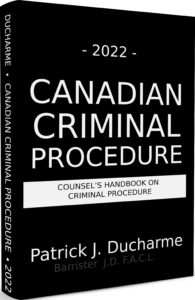 |
| Patrick Ducharme |
The Supreme Court of Canada’s decision in R. v. St- Cloud is best known and most often cited for its decision concerning whether the detention of an accused is necessary to maintain confidence in the administration of Justice. The decision in this regard suggests that the presiding Justice must first consider the four circumstances that are expressly referred to in subsection 515 (10). However, the decision is equally important for its commentary and directions concerning applications to review a bail decision by the defence pursuant to section 520, and the prosecution pursuant to section 521 of the Code.
Rule 20 of the Criminal Proceedings Rules applies to reviews. A notice of application with supporting materials must be served on the opposite party at least two clear days before the application is to be heard in accordance subsection 520(2) of the Code. Counsel should interpret “two clear days” as meaning three days before the application is to be heard. This notice requirement may be abridged with the consent of the prosecutor or upon leave being granted by the court. The notice must also state whether the accused is to be present at the hearing.
When the application is made by the accused, she must file an affidavit that includes particulars of the charge; outstanding charges; upcoming dates for either preliminary and/or trial; where the accused has lived in the prior three years, and, where the accused intends to live if released; the employment record of the accused over the last three years, and, whether the accused has employment presently available and the form of release that the accused seeks, together with information respecting her sureties.
An application for review by the prosecutor essentially mirrors the provisions required of the accused. The only essential difference is that the prosecutor faces the same notice requirements, but there is no corresponding ability for the accused to waive the notice requirement. If the Judge on review decides that the accused must be detained in custody the Judge issues a warrant for the committal of the accused.2
When an application for review has been made, a further or other application, shall not be made with respect to the same accused, except with leave of a Judge prior to the expiration of thirty days from the date of the decision of the Judge who heard the previous application.3 Further, applications should be made to the same Superior Court Judge unless there have been intervening events which require the granting of leave to be heard by another Judge in the interests of justice4 so as to avoid “Judge shopping”. Reviews are governed by sections 520 and 521 of the Criminal Code.
The court in R. v. St-Cloud offered its opinion on the nature and extent of a review of the Justice’s decision at the original bail hearing or bail review hearing pursuant to sections 520 and 521 of the Code. The court found that that these sections do not confer an open-ended discretion on the reviewing Judge to vary the initial decision concerning the detention or release of the accused. Instead, the court found that exercising this power of review will be appropriate in only three circumstances:
1. where there is admissible new evidence that demonstrates a material and relevant change in circumstances.
2. where the impugned decision contains an error of law; or
3. where the impugned decision is clearly inappropriate.
The court also endorsed these criteria from their earlier decision in Palmer v. the Queen.6 The court suggested that the reviewing Judge must be flexible in applying the following criteria:
a. the reviewing Judge may consider evidence that is truly new evidence, or evidence that existed at the time of the initial release hearing but was not tendered for a legitimate and reasonable reason. In other words, counsel on behalf of the accused should be able to demonstrate that even with due diligence the newly proffered evidence was unavailable, or perhaps unknown through no fault of counsel, at the time of the bail hearing, or, unknown for another legitimate reason.
b. although the range of relevant evidence is generally quite broad, it will suffice that the evidence is demonstrably relevant for the purposes of subsection 515 (10).
c. the evidence tendered must be credible in the sense that it is reasonably capable of belief. This criterion must be interpreted in light of the relaxation of the rules of evidence at a bail hearing and in particular with reference to the relaxation of the rules outlined in section 518 of the Code and the fact that evidence that is considered credible or trustworthy may be considered admissible in the circumstances of each case.
The new evidence must be such that it is reasonable to think, having regard to all the relevant circumstances, that it could have affected the balancing exercise engaged in by the Justice who presided over the original hearing.
Where “new evidence” is to be considered, R. v. St-Cloud has adopted four important criteria for Justices to consider on review applications pursuant to sections 520 and 521 of the Code. A reviewing Justice must be flexible in applying these criteria.7 The first is due diligence. The reviewing Judge should only consider evidence that is truly new, or evidence that existed at the time of the initial release hearing but was not tendered for some reason that is legitimate and reasonable. The reviewing Justice must determine whether the reason(s) why the accused did not tender pre-existing evidence earlier was legitimate and reasonable.
The “new” evidence on review must be relevant. The evidence must also be credible to the extent that it is reasonably capable of belief, but not to make this requirement too stringent it must also be interpreted in light of the relaxation of the rules of evidence permitting credible or trustworthy evidence, and, in light of the constitutional entitlement to bail provided for in the Charter.
Lastly, the new evidence must be such that it is reasonable to think, in all the circumstances, that the new evidence could have affected the decision made by the Justice at the first bail hearing in favour of the applicant. It is also appropriate, of course, to intervene on review if the Justice has erred in law, or, if the impugned decision was clearly inappropriate.

The above is the an excerpt of Patrick J Ducharme's book, Canadian Criminal Procedure, available at Amazon or in bulk through MedicaLegal Publishing along with Criminal Trial Strategies.
Subscribe to Patrick Ducharme's Youtube Channel
